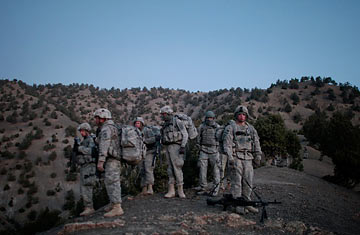
U.S. soldiers prepare to leave a Taliban stronghold where they spent the night in Paktika province, Afghanistan
The acceptance by Afghanistan's President Hamid Karzai that ballot fraud has stripped him of his first-round re-election victory potentially removes the last obstacle cited by the Obama Administration to sending thousands more U.S. troops into the war. White House chief of staff Rahm Emanuel said over the weekend that reinforcements could not be sent until the allegations of electoral fraud had been resolved, because the U.S. counterinsurgency strategy depends on defending a legitimate government. But the Afghan electoral commission's ruling that, after fraudulent ballots were discarded, Karzai had failed to win an outright majority in the first round of voting means that he'll have to face a runoff race against his closest challenger, former Foreign Minister Abdullah Abdullah.
The White House logic that a decision on sending further troops would have to wait for the election debacle to be resolved is faulty, however. And Defense Secretary Robert Gates was among those willing to point that out. "We're not just going to sit on our hands, waiting for the outcome of this election and for the emergence of a government in Kabul," Gates said Tuesday. "The outcome of the elections and the problems with the elections have complicated the situation for us. But the reality is, it's not going to be complicated one day and simple the next."
Indeed, for purposes of creating a representative government as the foundation of U.S. counterinsurgency strategy, the key flaw of Afghanistan's August election was not the widespread ballot fraud; it was the fact that almost 3 out of 4 voters didn't show up at the polls because of the Taliban security threat. So, while a runoff election might satisfy the fraud complaints, it won't make the resulting government much more representative unless millions more voters show up at the polls this time. But the deteriorating security situation and limits of the appeal of both candidates give little reason to expect that the rerun would see a voter surge; turnout in a runoff, if anything, could be even lower.
What's more, despite the findings of the electoral commission, there's widespread doubt in Kabul over whether a runoff vote will actually proceed. A power-sharing deal between Karzai and Abdullah is considered the much more likely outcome. But in reality, the manner in which the electoral stalemate is resolved doesn't substantially alter the basic choice facing Obama: either send tens of thousands more U.S. troops, which U.S. commander General Stan McChrystal says are necessary simply to halt the Taliban's advance, or draw down to a policing operation against al-Qaeda and abandon the goal of defeating the Taliban.
McChrystal reportedly offered Obama different options graded by risk. He is said to have suggested that adding even 20,000 more to the 68,000 already committed to the fight would still run a high risk of failure, while that risk would be lowest if the White House dispatched a further 60,000 to 80,000 troops. The reinforcement number talked about in many of the press reports on Obama's dilemma — a little upward of 40,000 new troops — represents McChrystal's medium risk scenario.
The problem with trying to restrict troop levels and focus instead on accelerating the training of Afghan forces, as many skeptics of escalation have proposed, is that it offers the worst of both worlds. It would deny McChrystal the reinforcements he believes are essential to avoid defeat ("Resources will not win this war, but under-resourcing could lose it," says the general). But at the same time, it would do little to shield the President from criticism on the left that he is squandering American lives and treasure on an unwinnable war.
So, as long as President Obama is unwilling to countenance a withdrawal in defeat, he may be tempted by the logic of an old British idiom on the metric of risk: "In for a penny, in for a pound."
Even if the skeptics are correct and a military victory over the Taliban remains unlikely, the next best option — negotiating some form of compromise with the Taliban, involving shutting out al-Qaeda and some form of power-sharing with the elected government — would require convincing the insurgents that they can't win on the battlefield. Surging tens of thousands more U.S. troops into the Afghan theater may be necessary if the goal is simply to fight this one to a tie. (Logistical constraints, however, suggest that the surge may be more of a dribble, with the U.S. currently lacking the capability to deploy more than about 4,000 new troops in Afghanistan each month.)
A resolution of the election dispute will no doubt be touted as evidence of progress to convince skeptical Democrats of the need for reinforcements, although the sweetener will be a promise to dramatically expand the training of Afghan security forces. But in the near term, the Afghan National Army (ANA) will be little more than a sidebar to the deployment of thousands more U.S. troops to hold the line against the Taliban. The ANA ostensibly numbers some 95,000 troops right now, but its capacity to fight the Taliban remains difficult to assess. It is certainly not immune to the political conflicts driving the insurgency; it is dominated by an ethnic Tajik officer corps viewed with resentment by Afghanistan's largest ethnic group, the Pashtuns, who are also the Taliban's social base. Training may be just one challenge in developing an army willing and able to fight what at present would be seen as those on the side of foreign forces in the middle of a civil war.
Despite well-founded fears of the rising cost of an open-ended war, Obama does not want to be the President who presided over a defeat in Afghanistan. In which case, his options are a lot narrower than the weeks of debate over the issue suggest, regardless of how the election debacle plays out.
